The contributions of women today and throughout history have had an impact on every corner of society, from family life to politics and so much more. International Literacy Association’s Children’s Literature and Reading SIG presents new titles featuring the memorable contributions made by women both historical and contemporary. More resources are available at the Women’s History Month website, including material from The Library of Congress, National Archives, National Gallery of Art, National Park Service, Smithsonian Institution, United States Holocaust Memorial Museum, and National Endowment for the Humanities.
Ages 4–8
Deans, Karen. (2015). Swing Sisters: The Story of the International Sweethearts of Rhythm. Illus. by Joe Cepeda. New York, NY: Holiday House.
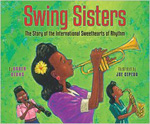 This informational picture book tells the background and history of the International Sweethearts of Rhythm all-girl interracial swing band of the mid-1940s. Dr. Laurence Clifton Jones founded the Piney Woods Country Life School, a home for African American orphans, in Jackson, MS, in 1909. Dr. Jones creates the band in 1939, and the girls enthusiastically make the band a part of their lives. They first travel to local churches and school performance venues but later expand their travel tour to include music halls across the United States and Europe. When the band takes on new members from other races and nationalities, problems arise in the Jim Crow south where mixed race groups are not allowed to perform in certain establishments. Joe Cepeda’s oil and acrylic paint illustrations bring vibrancy to the text, making the music and rhythm of the story come alive. Though this book is intended for a younger audience, Marilyn Nelson’s The Sweethearts of Rhythm is a wonderful companion book for ages 10 and up. The publisher has created an educator guide with Common Core alignments for the book.
This informational picture book tells the background and history of the International Sweethearts of Rhythm all-girl interracial swing band of the mid-1940s. Dr. Laurence Clifton Jones founded the Piney Woods Country Life School, a home for African American orphans, in Jackson, MS, in 1909. Dr. Jones creates the band in 1939, and the girls enthusiastically make the band a part of their lives. They first travel to local churches and school performance venues but later expand their travel tour to include music halls across the United States and Europe. When the band takes on new members from other races and nationalities, problems arise in the Jim Crow south where mixed race groups are not allowed to perform in certain establishments. Joe Cepeda’s oil and acrylic paint illustrations bring vibrancy to the text, making the music and rhythm of the story come alive. Though this book is intended for a younger audience, Marilyn Nelson’s The Sweethearts of Rhythm is a wonderful companion book for ages 10 and up. The publisher has created an educator guide with Common Core alignments for the book.
—KH
Krull, Kathleen. (2015). Women Who Broke the Rules: Dolley Madison. Illus. by Steve Johnson. New York, NY: Bloomsbury Children’s. (Release date June 9)
 As is Kathleen Krull’s style, she combines humor and fact to bring the life of First Lady Dolley Madison, wife of James Madison, to young readers. Dolley, one of the most memorable among the First Ladies, is known especially for her Wednesday night parties—she believes politics and social activity are a needed partnership in Washington, DC. Her most famous daring act is often considered to be saving the portrait of George Washington before the burning of the White House by the British troops during the War of 1812. This enjoyable and informative biography is just right for early readers. Other titles in the Women Who Broke the Rules series include Sonia Stomayor, Sacajawea, and Judy Blume.
As is Kathleen Krull’s style, she combines humor and fact to bring the life of First Lady Dolley Madison, wife of James Madison, to young readers. Dolley, one of the most memorable among the First Ladies, is known especially for her Wednesday night parties—she believes politics and social activity are a needed partnership in Washington, DC. Her most famous daring act is often considered to be saving the portrait of George Washington before the burning of the White House by the British troops during the War of 1812. This enjoyable and informative biography is just right for early readers. Other titles in the Women Who Broke the Rules series include Sonia Stomayor, Sacajawea, and Judy Blume.
—KH
McCully, Emily Arnold. (2015). The Queen of the Diamond: The Lizzie Murphy Story. New York, NY: Farrar Straus Giroux Books for Young Readers.
 Born in 1894, Lizzie Murphy is told baseball is a game for boys, yet she plays better than most of them. Despite her mother’s protests, her father and brother encourage her to develop her natural talents. Murphy is signed to play semiprofessional baseball at age 18, but when the men are paid and she is passed over, she refuses to play unless she receives equal pay. Murphy spends the next 17 years of her life playing baseball, and she becomes the first person to play on the National and the American Leagues’ all-star teams. The author’s lively illustrations allow young readers to see Murphy grow from a 6-year-old to a young woman of 18, and they effectively convey both the action of the game and the characters’ emotions. An author’s note provides information about Murphy’s life beyond what is portrayed in the picture book. This is an excellent introduction to an important, yet relatively unknown, pioneering woman athlete.
Born in 1894, Lizzie Murphy is told baseball is a game for boys, yet she plays better than most of them. Despite her mother’s protests, her father and brother encourage her to develop her natural talents. Murphy is signed to play semiprofessional baseball at age 18, but when the men are paid and she is passed over, she refuses to play unless she receives equal pay. Murphy spends the next 17 years of her life playing baseball, and she becomes the first person to play on the National and the American Leagues’ all-star teams. The author’s lively illustrations allow young readers to see Murphy grow from a 6-year-old to a young woman of 18, and they effectively convey both the action of the game and the characters’ emotions. An author’s note provides information about Murphy’s life beyond what is portrayed in the picture book. This is an excellent introduction to an important, yet relatively unknown, pioneering woman athlete.
—LP
Turner, Ann. (2015). My Name Is Truth: The Life of Sojourner Truth. Illus. by James Ransome. New York, NY: HarperCollins.
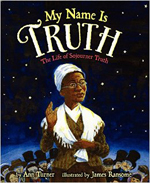 Born a slave named Isabella Baumfree, as a young girl she is sold several times to various plantation owners. As told through the free-verse form of author Ann Turner, Isabella narrates her story and changes her name to Sojourner Truth. She becomes a preacher and advocate for freedom and women’s rights at a time when very few people shared these beliefs. James Ransome’s bold illustrations for this picture book biography represent the outspoken courage of this woman as she pursues the abolitionist movement and becomes the voice of the enslaved. Written as a first-person narrative rather than an autobiography, quotes from Sojourner are used throughout the book though the sources for these quotes are not given. This is a strong, beautifully written and illustrated book but will be best used with other factual accounts of this extraordinary woman.
Born a slave named Isabella Baumfree, as a young girl she is sold several times to various plantation owners. As told through the free-verse form of author Ann Turner, Isabella narrates her story and changes her name to Sojourner Truth. She becomes a preacher and advocate for freedom and women’s rights at a time when very few people shared these beliefs. James Ransome’s bold illustrations for this picture book biography represent the outspoken courage of this woman as she pursues the abolitionist movement and becomes the voice of the enslaved. Written as a first-person narrative rather than an autobiography, quotes from Sojourner are used throughout the book though the sources for these quotes are not given. This is a strong, beautifully written and illustrated book but will be best used with other factual accounts of this extraordinary woman.
—KH
Ages 9–11
Bradley, Kimberly Brubaker. (2015). The War That Saved My Life. New York, NY: Dial.
 Imprisoned by Mam in their one-room flat because of her untreated clubfoot, Ada knows love only from her younger brother, Jamie. When he is evacuated from World War II London, Ada secretly goes with him. Arriving in Kent malnourished and filthy, Ada and Jamie are reluctantly taken in by Susan, who deems herself “not a nice person.” Yet Susan and the children come to trust and rely on each other as the months pass. Ada heals emotionally and physically from the trauma of abuse as she learns to ride and care for Butter, Susan’s pony, and as she enters the world for the first time. There is much Ada doesn’t understand, but Susan patiently teaches her and, despite Ada’s mistakes, assures her she “will not hit her.” Ada narrates her story, and her naïve voice adds poignancy to her growing awareness that she is more than her disability. This is a gentle story of finding love, family, and home amid the uncertainty of war.
Imprisoned by Mam in their one-room flat because of her untreated clubfoot, Ada knows love only from her younger brother, Jamie. When he is evacuated from World War II London, Ada secretly goes with him. Arriving in Kent malnourished and filthy, Ada and Jamie are reluctantly taken in by Susan, who deems herself “not a nice person.” Yet Susan and the children come to trust and rely on each other as the months pass. Ada heals emotionally and physically from the trauma of abuse as she learns to ride and care for Butter, Susan’s pony, and as she enters the world for the first time. There is much Ada doesn’t understand, but Susan patiently teaches her and, despite Ada’s mistakes, assures her she “will not hit her.” Ada narrates her story, and her naïve voice adds poignancy to her growing awareness that she is more than her disability. This is a gentle story of finding love, family, and home amid the uncertainty of war.
—LP
Doak, Robin S. (2015). Malala Yousafzai. New York, NY: Children’s Press.
 History continues to be made when young girls like Malala Yousafzai speak out about human and civil rights or the rights of girls to seek an education. This biography tells the story of 11-year old Malala growing up in Pakistan. When Malala’s blog about girls needing an education becomes popular and she is invited to meet the chief minister of Punjab and the media, religious extremists find her words to be rebellious. In October 2012, Taliban forces attempt to quiet this outspoken young girl and shoot her as she boards the bus to school. Fighting for her life, Malala is sent to England to receive medical treatment and a haven in which to recover. This book details the path Malala has chosen to fight for the rights of oppressed girls and women living under terrorist demands. To extend the story of Malala’s life, visit her website or share the content of her Nobel Prize lecture.
History continues to be made when young girls like Malala Yousafzai speak out about human and civil rights or the rights of girls to seek an education. This biography tells the story of 11-year old Malala growing up in Pakistan. When Malala’s blog about girls needing an education becomes popular and she is invited to meet the chief minister of Punjab and the media, religious extremists find her words to be rebellious. In October 2012, Taliban forces attempt to quiet this outspoken young girl and shoot her as she boards the bus to school. Fighting for her life, Malala is sent to England to receive medical treatment and a haven in which to recover. This book details the path Malala has chosen to fight for the rights of oppressed girls and women living under terrorist demands. To extend the story of Malala’s life, visit her website or share the content of her Nobel Prize lecture.
—KH
Grimes, Nikki. (2015). Chasing Freedom: The Life Journeys of Harriet Tubman and Susan B. Anthony.New York, NY: Orchard.
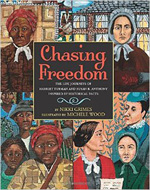 What if Harriet Tubman and Susan B. Anthony had sat down together over a cup of tea? To share their life experiences? Coretta Scott King Award winning author/poet Nikki Grimes begins her book with this premise, and the two women relate the many happenings during their lives as they both worked for civil rights—from slavery to women’s rights. Michele Wood’s beautiful illustrations drawn from African American folk art quilts add to the background of each woman’s experiences and stories. This book begs to be read aloud and gives students an opportunity to discuss not only the content but also the writing style.
What if Harriet Tubman and Susan B. Anthony had sat down together over a cup of tea? To share their life experiences? Coretta Scott King Award winning author/poet Nikki Grimes begins her book with this premise, and the two women relate the many happenings during their lives as they both worked for civil rights—from slavery to women’s rights. Michele Wood’s beautiful illustrations drawn from African American folk art quilts add to the background of each woman’s experiences and stories. This book begs to be read aloud and gives students an opportunity to discuss not only the content but also the writing style.
—KH
Hannigan, Kate. (2015). The Detective’s Assistant. New York, NY: Little, Brown and Company. (Release date April 7)
 Eleven-year-old Nell Warne arrives at Aunt Kitty’s doorstep orphaned and unwelcomed. In danger of being placed in the Home for the Friendless, Nell determines to become indispensible to her aunt. Although she begins with chores for the landlady, Nell soon steps in to help Aunt Kitty with her work as the first female detective employed by the Pinkerton Detective Agency. Mr. Pinkerton discovers that Nell’s courage, initiative, determination, and intelligence are exactly what he needs in a detective’s assistant. In addition to helping solve cases for the agency, Nell solves a long-standing mystery about her father. Set against the backdrop of Civil War era America and Abraham Lincoln’s election to the presidency, this fast-paced adventure is based on the life of Kate Warne. At the end of the book, an author’s note gives information about the real Kate Warne, answers to ciphers embedded in the novel are revealed, and budding detectives are given resources for additional reading.
Eleven-year-old Nell Warne arrives at Aunt Kitty’s doorstep orphaned and unwelcomed. In danger of being placed in the Home for the Friendless, Nell determines to become indispensible to her aunt. Although she begins with chores for the landlady, Nell soon steps in to help Aunt Kitty with her work as the first female detective employed by the Pinkerton Detective Agency. Mr. Pinkerton discovers that Nell’s courage, initiative, determination, and intelligence are exactly what he needs in a detective’s assistant. In addition to helping solve cases for the agency, Nell solves a long-standing mystery about her father. Set against the backdrop of Civil War era America and Abraham Lincoln’s election to the presidency, this fast-paced adventure is based on the life of Kate Warne. At the end of the book, an author’s note gives information about the real Kate Warne, answers to ciphers embedded in the novel are revealed, and budding detectives are given resources for additional reading.
—LP
Hile, Lori. (2014). Rachel Carson: Environmental Pioneer. Chicago, IL: Heinemann Library.
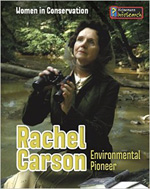 This addition to the Women in Conservation series profiles Rachel Carson: scientist, writer, and reformer. Photographs document Carson’s life from early childhood through adulthood in personal as well as professional settings. “Did you know?” and “In her own words” sidebars supplement the main text, which begins with Carson’s childhood, focuses on her career (including roadblocks she encountered as a woman), and ends with her legacy. Hile explains how Carson’s early interest in writing and her subsequent switch to biology prepares Carson to write about scientific concepts for the general public. She explores the chemical companies’ anger and outrage after the publication of Silent Spring, Carson’s groundbreaking book about the dangers of the pesticide DDT. The back matter contains a timeline, glossary, additional references, and an index. Middle-grade conservationists will be inspired by Carson’s story and will learn specific things they can do to protect the planet.
This addition to the Women in Conservation series profiles Rachel Carson: scientist, writer, and reformer. Photographs document Carson’s life from early childhood through adulthood in personal as well as professional settings. “Did you know?” and “In her own words” sidebars supplement the main text, which begins with Carson’s childhood, focuses on her career (including roadblocks she encountered as a woman), and ends with her legacy. Hile explains how Carson’s early interest in writing and her subsequent switch to biology prepares Carson to write about scientific concepts for the general public. She explores the chemical companies’ anger and outrage after the publication of Silent Spring, Carson’s groundbreaking book about the dangers of the pesticide DDT. The back matter contains a timeline, glossary, additional references, and an index. Middle-grade conservationists will be inspired by Carson’s story and will learn specific things they can do to protect the planet.
—LP
Schatz, Kate. (2015). Rad American Women A-Z. Illus. by Miriam Klein Stahl. San Francisco, CA: City Lights. (Release date April 7)
 The introduction to this abecedary asks what it means to be rad, and then explores the many ways women have been radical throughout history: from the Latin meaning “from the root” to being something out of the ordinary. The book features a multicultural cast of women from Angela Davis to Dolores Huerta to Maya Lin and Wilma Mankiller in careers as varied as comedy, athletics, dance, aviation, ecology, and law. The 26 one-page biographies are well written, readable introductions to these women and how they made an impact on the world. The book ends with an alphabet of 26 things readers can do to be rad, and a resource guide lists books, websites, and organizations of interest to readers who want more information or who want to start making a difference now.
The introduction to this abecedary asks what it means to be rad, and then explores the many ways women have been radical throughout history: from the Latin meaning “from the root” to being something out of the ordinary. The book features a multicultural cast of women from Angela Davis to Dolores Huerta to Maya Lin and Wilma Mankiller in careers as varied as comedy, athletics, dance, aviation, ecology, and law. The 26 one-page biographies are well written, readable introductions to these women and how they made an impact on the world. The book ends with an alphabet of 26 things readers can do to be rad, and a resource guide lists books, websites, and organizations of interest to readers who want more information or who want to start making a difference now.
—LP
Ages 12–14
Crowder, Melanie. (2015). Audacity. New York, NY: Philomel.
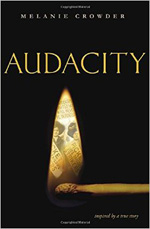 This powerful novel in verse is inspired by Clara Lemlich’s life story. The only girl in an Orthodox Jewish family, Clara is forbidden to speak or read Russian, yet she defies her father and trades work for words and books. When her family emigrates to escape the pogroms, Clara finds no more freedom in America than in Russia. As her father and brothers study the Torah, she works in a sweatshop where the girls work long hours in unsafe conditions and are sexually harassed. Despite all this, Clara finds the public library and the free school, where she pursues her dream of an education. Clara cannot remain silent, however, and gives up her dream of an education for another dream: to stand up for the rights of the girls in the sweatshops. Although she is beaten by thugs and strikebreakers, jailed repeatedly, and blacklisted, she persists in her fight and ultimately leads the Uprising of the 20,000. A historical note gives context to the novel, and an interview with the author and Lemlich’s children and grandchildren provides a personal glimpse into how this remarkable woman lived out her life. Teachers might like to open this book with the picture book biography by Michelle Markel entitled, Brave Girl: Clara and the Shirtwaist Makers’ Strike of 1909.
This powerful novel in verse is inspired by Clara Lemlich’s life story. The only girl in an Orthodox Jewish family, Clara is forbidden to speak or read Russian, yet she defies her father and trades work for words and books. When her family emigrates to escape the pogroms, Clara finds no more freedom in America than in Russia. As her father and brothers study the Torah, she works in a sweatshop where the girls work long hours in unsafe conditions and are sexually harassed. Despite all this, Clara finds the public library and the free school, where she pursues her dream of an education. Clara cannot remain silent, however, and gives up her dream of an education for another dream: to stand up for the rights of the girls in the sweatshops. Although she is beaten by thugs and strikebreakers, jailed repeatedly, and blacklisted, she persists in her fight and ultimately leads the Uprising of the 20,000. A historical note gives context to the novel, and an interview with the author and Lemlich’s children and grandchildren provides a personal glimpse into how this remarkable woman lived out her life. Teachers might like to open this book with the picture book biography by Michelle Markel entitled, Brave Girl: Clara and the Shirtwaist Makers’ Strike of 1909.
—LP
Langley, Andrew. (2015). Stories of Women in World War II: We Can Do It! Mankato, MN: Heinemann/Raintree.
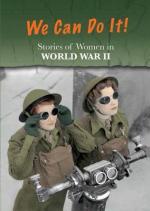 Though Rosie the Riveter has become the iconic figure of women doing the work of men during World War II, there were other real women doing dangerous and heroic jobs as well. This book features four of these women and details their contributions to life during the war. Red Harrington is a nurse who is captured by the Japanese. Red and her fellow nurses establish a hospital to care for prisoners of war. Nancy Love is a pilot who proves that young women can step into the cockpits of a plane as well as a man. The photograph of Ruby Loftus operating large machinery is often used in textbooks and other books on World War II and the home front. Anne-Marie Walters is a secret agent working behind enemy lines in France. Other books in this series include Stories of Women During the Industrial Revolution, Stories of Women in the 1960s, and Stories of Women’s Suffrage.
Though Rosie the Riveter has become the iconic figure of women doing the work of men during World War II, there were other real women doing dangerous and heroic jobs as well. This book features four of these women and details their contributions to life during the war. Red Harrington is a nurse who is captured by the Japanese. Red and her fellow nurses establish a hospital to care for prisoners of war. Nancy Love is a pilot who proves that young women can step into the cockpits of a plane as well as a man. The photograph of Ruby Loftus operating large machinery is often used in textbooks and other books on World War II and the home front. Anne-Marie Walters is a secret agent working behind enemy lines in France. Other books in this series include Stories of Women During the Industrial Revolution, Stories of Women in the 1960s, and Stories of Women’s Suffrage.
—KH
Ages 15+
Caravantes, Peggy. (2015). The Many Faces of Josephine Baker: Dancer, Singer, Activist, Spy. Chicago, IL: Chicago Review Press.
 Author Peggy Caravantes worked through many challenges as she researched the life of the flamboyant and controversial Josephine Baker. Baker’s early life in the 1900s is one of poverty and few recorded facts. Her mother pushes her to work at an extremely early age. Josephine marries Willie Baker as a teen, and though she leaves Willie she kept his name her entire life. Starting in vaudeville, she becomes quite popular as a comedic entertainer and demonstrates talent in singing and dancing as well. As her fame grows, she eventually leaves for France and starts a life in Paris. Her popularity continues, and she acquires her fortune at the time. In addition to her stage life, she also works for the French Resistance as a spy for the Allies during World War II, which earns her the French War Cross. Along the way, she adopts 12 children from various races, religions, and ethnicities, known as her Rainbow Tribe. During these years, Baker also becomes an outspoken advocate for civil rights, demanding that integrated audiences be allowed into her shows—something that isn’t allowed in the United States. This well-researched biography for teen readers also includes photographs, chapter notes, and an excellent bibliography.
Author Peggy Caravantes worked through many challenges as she researched the life of the flamboyant and controversial Josephine Baker. Baker’s early life in the 1900s is one of poverty and few recorded facts. Her mother pushes her to work at an extremely early age. Josephine marries Willie Baker as a teen, and though she leaves Willie she kept his name her entire life. Starting in vaudeville, she becomes quite popular as a comedic entertainer and demonstrates talent in singing and dancing as well. As her fame grows, she eventually leaves for France and starts a life in Paris. Her popularity continues, and she acquires her fortune at the time. In addition to her stage life, she also works for the French Resistance as a spy for the Allies during World War II, which earns her the French War Cross. Along the way, she adopts 12 children from various races, religions, and ethnicities, known as her Rainbow Tribe. During these years, Baker also becomes an outspoken advocate for civil rights, demanding that integrated audiences be allowed into her shows—something that isn’t allowed in the United States. This well-researched biography for teen readers also includes photographs, chapter notes, and an excellent bibliography.
—KH
Conkling, Winifred. (2015). Passenger on the Pearl: The True Story of Emily Edmonson’s Flight From Slavery. New York, NY: Algonquin/Workman.
 Set in 1848, the author presents a detailed account of one of the greatest escape attempts from slavery ever made in the pre–Civil War era. Emily Edmonson and her five siblings board The Pearl on the Potomac River near Washington, DC and try to find freedom as the ship is scheduled to sail north. Sadly, the ship is captured shortly after departure, and Emily, her siblings and the 70 other escaping slaves are halted, imprisoned, and sent to New Orleans to be sold again. A variety of primary source material including archival photographs and sidebars provides additional information that extends the narrative to give context for the time period. This escape attempt, though failed, gains national attention in the United States and abolitionists use the incident to rally their cause. Northern sympathizers are able to buy the freedom of Emily and Mary Edmonson, who are then educated to become teachers. It is this incident from history that inspires the writer Harriet Beecher Stowe to pen the classic book Uncle Tom’s Cabin. The book concludes with a timeline, family tree, source notes, bibliography, and index.
Set in 1848, the author presents a detailed account of one of the greatest escape attempts from slavery ever made in the pre–Civil War era. Emily Edmonson and her five siblings board The Pearl on the Potomac River near Washington, DC and try to find freedom as the ship is scheduled to sail north. Sadly, the ship is captured shortly after departure, and Emily, her siblings and the 70 other escaping slaves are halted, imprisoned, and sent to New Orleans to be sold again. A variety of primary source material including archival photographs and sidebars provides additional information that extends the narrative to give context for the time period. This escape attempt, though failed, gains national attention in the United States and abolitionists use the incident to rally their cause. Northern sympathizers are able to buy the freedom of Emily and Mary Edmonson, who are then educated to become teachers. It is this incident from history that inspires the writer Harriet Beecher Stowe to pen the classic book Uncle Tom’s Cabin. The book concludes with a timeline, family tree, source notes, bibliography, and index.
—KH
Karen Hildebrand is a retired library media specialist anad reading consultant in Ohio. Linda T. Parsons is a Linda T. Parsons is an associate professor at the School for Teaching and Learning at Ohio State University and holds a PhD in Language, Literacy, and Culture. She is an experienced classroom teacher and her research interests include children’s engagement during aesthetic reading and the impact of gender on literacy. These reviews are submitted by members of the International Reading Association's Children's Literature and Reading Special Interest Group (CL/R SIG)and are published weekly on Reading Today Online.